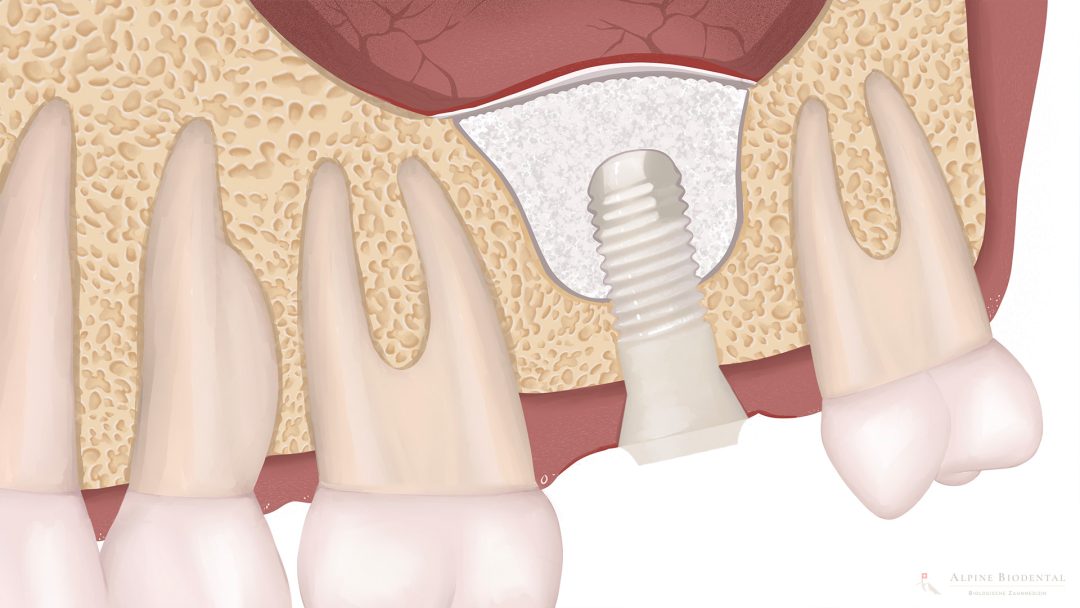Sinus Lift

The term sinus lift is made up of:
- Sinus maxillaris = maxillary sinus
- Lift = to lift, raise
The sinus lift is a surgical procedure that is used to build up the bone of the upper jaw and to provide stability for one or more dental implants. If the bone height in the maxillary posterior region is too low and an implant is to be placed, a decision must be made between a short implant or a normal implant length with an internal or external sinus lift.
As a longer implant provides better stability and allows a favorable pressure distribution in the bone, the sinus lift is a frequently performed, proven procedure.
What is a Sinus Lift?
A sinus lift, also known as sinus floor elevation, is a surgical technique that is performed to protect the maxillary sinus in the upper jaw and to gain height for implant placement. It is necessary if the vertical bone height is too low.
The maxillary sinuses (paranasal sinuses) are located on the right and left sides of the nasal region. They serve to warm, humidify and clean the air; as they are hollow, they help to reduce the weight of the head and amplify the resonance of the voice.
As the maxillary sinus is an air-filled cavity, it is not possible to insert an implant into it, as this would cause irritation and understandably not stabilize the implant. The bone level must therefore be raised, which we would like to discuss in the following text.
All of the following procedures have in common that the mucous membrane of the maxillary sinus (= Schneiderian membrane) must be lifted in order to raise the underlying bone. By lifting the floor of the maxillary sinus, a cavity is created which is filled with new bone. This new bone is used to anchor an implant stably.
Internal Sinus Lift - indirect Sinus Lift
The internal sinus lift, also known as internal sinus floor elevation or indirect sinus lift, is used when only a few millimeters in height (certainly up to 3 mm, in individual cases up to 5 mm) are required in addition to the initial situation. The procedure is only carried out in the area of the implant.
It is important that the implant is first drilled to just below the bony floor of the maxillary sinus. Osteotomes are then used to drill through this hole and carefully tap the end of the instrument to push up the mucous membrane of the maxillary sinus and the bone. The implant, which is then placed, holds the mucosa and bone up with its tip, which heals in this position and stabilizes and anchors the implant.
The procedure is very minimally invasive, requires no additional incision and only takes a few minutes. No bone replacement material is required; only the patient’s own bone and blood are used.
External Sinus Lift - direct Sinus Lift
The external sinus lift, also known as an external sinus floor elevation, lateral sinus lift or direct sinus lift, is required for larger bone requirements. The gums are dissected off to the side of the alveolar ridge, carefully held to the side and a separate access is made deep into the maxillary sinus. In this case, bone augmentation is not carried out via the implant drill hole. The mucosa of the maxillary sinus is pushed upwards through the lateral access window using rounded instruments. Both the fenestration of the jawbone and the careful detachment of the maxillary sinus mucosa can be performed minimally invasively and atraumatically with the help of piezo surgery.
The resulting cavity is filled with autologous bone and/or bone substitute material. In some cases, it may be advisable to use a mixture of the patient’s own bone and replacement material (e.g. beta-tricalcium phosphate). This combines the durability and long-term stability of the replacement material with the good properties of the patient’s own bone.
We would be happy to discuss the treatment options and material selection with you personally in the practice.
Nasal Lift / Nose Lift
The nasal lift is a variation of the internal sinus lift. If the bone height in the anterior region is too low, the mucosa can be pushed upwards using fine osteotomes and held upwards by implants placed at the same time. It is not the mucous membrane of the maxillary sinus that is pushed upwards, but the mucous membrane of the nose, hence the name nasal lift. The procedure is identical to the internal sinus lift, only the region differs.
Intralift
With an intralift, the mucosa is lifted over the drill hole of the implant, as with an internal sinus lift. A jet of water is directed into the drill hole using a piezotomy with fine diamond tips. This lifts the mucous membrane so that bone replacement material, autologous bone or the implant can be placed directly. As the technique can be accompanied by unseen ruptures of the membrane (possible openings of the maxillary sinus that go unnoticed), we only use this technique after weighing up the alternatives.
Sinus Lift with simultaneous Implant
In an internal sinus lift and nasal lift, the dental implant should be placed at the same time in order to maintain the additional bone height. With an external sinus lift, simultaneous implant placement is possible if there is sufficient height for anchoring the implant. The patient’s own residual bone height should be at least 3 mm; otherwise a two-stage procedure is necessary.
At Alpine BioDental, we try to combine the sinus lift with immediate implant placement wherever possible. In this way, unpleasant multiple procedures can be avoided, despite little bone, and the patient can achieve their goal quickly and easily.
Restrictions after a Sinus Lift
A sinus lift is a surgical procedure that is accompanied by certain restrictions specific to the operation. The following three measures are designed to ensure that no additional pressure builds up in the newly operated maxillary sinuses:
- The most important restriction after a sinus lift is the ban on blowing your nose. You should not blow your nose for two weeks after the operation to avoid pressure.
- Please sneeze with your mouth open so that pressure can escape and not build up. Do not swallow the sneeze.
- Please do not fly, dive, climb high mountains, do intensive sport, lift heavy objects or play wind instruments for two weeks after the operation.
Risks associated with a Sinus Lift
As with any surgical procedure, there are various risks associated with a sinus lift that you should be aware of.
- There may be soreness after the operation, which can be alleviated with natural painkillers or pharmaceuticals such as ibuprofen, paracetamol or mefenacid if necessary. It is very helpful to cool the cheek after the operation. Slight swelling is possible and will subside a few days after the operation.
- Wound healing disorders or infection are very rare risks of the procedure, which should be clarified in the practice if they are suspected.
- As with any surgical treatment, there is a risk of post-operative bleeding. A small amount of secondary bleeding is normal and unproblematic. However, if there is more bleeding, moisten a clean cotton cloth and press it onto the bleeding area for approx. 30 minutes. Contact your dentist or oral surgeon.
- In rare cases, an open maxillary sinus can occur. This is a rare complication, which is also known as a mouth-antrum junction (MAJ). In such a case, infection of the maxillary sinus should be avoided and rapid healing of the maxillary sinus mucosa should be promoted. To this end, measures such as ozone, A-PRF, tight wound closure and atraumatic surgical techniques are highly recommended.
Dr. med. dent. Josephine Phillips
We perform sinus lifts atraumatically and use autologous bone or compatible bone substitutes. We will be happy to help you.

Frequently asked Questions about Sinus Lift
In the following text, we would like to answer the most frequently asked questions that our patients ask us about sinus lift surgery.
Sinus lift surgery can be performed either internally or externally (see above).
An internal sinus lift usually only takes a few minutes. The lift is limited locally to the area where the implant tip is placed and is accompanied by implant drilling and insertion.
An external sinus lift takes longer than an internal sinus lift. It is more complex and requires a slow, careful and targeted approach. The total duration of the operation is approximately one hour.
There is almost no swelling after an internal sinus lift. If a tooth is removed at the same time, this is more likely to be caused by the extraction than by the minimally invasive, punctual internal sinus lift.
After an external sinus lift, swelling is more likely to occur compared to an internal sinus lift. Experience has shown that swelling is minimal, as we operate very carefully and keep the wound area as small as possible. If swelling does occur, it is usually limited to the cheek region. The swelling will subside after three days and disappear completely in the days following the operation.
As there is no sinus (i.e. no maxillary sinus) in the lower jaw, a sinus lift cannot be performed in the lower jaw.
Here, however, the mandibular nerve lies in its canal. If there is very little bone available, lateralization of the nerve should be considered, taking into account all other bone augmentation techniques that can be performed in the mandible.
The sinus lift is a long-established, classic surgical technique for gaining additional bone height in the upper jaw.
Experiences during the operation: The treatment is painless as it is performed under local anesthesia. You may feel slight pressure; you will also hear the sounds of our instruments. The sounds are comparable to those of a dental filling.
Experiences after the operation: Our patients feel very well after a sinus lift. Swelling, slight soreness or hematoma formation (bruising) are possible, but heal very quickly. These are only felt a few days after the operation, if at all. As we only use small incisions and do not pull on the tissue, our patients have good experiences with the procedure.
The success rate of a sinus lift is well over 90%. This is the figure given in the literature. Of course, the success rate is higher if the treatment is carried out by an experienced surgeon. The technique requires a very careful, cautious approach.
No, an open maxillary sinus rarely occurs with a sinus lift. However, it is a rare complication of this treatment.
As we make the access windows small and handle the maxillary sinus mucosa very carefully, perforations are unlikely. The individual risk depends on the nature of the mucous membrane (thickness) and the shape of the maxillary sinus (which can be assessed by X-ray).
If the rare situation of a perforation does occur, we can close it directly during treatment, covering it with A-PRF, collagen membrane and fine sutures of the mucosa depending on the situation.
Further information
The information listed contains relevant topics and is intended to provide a better understanding.